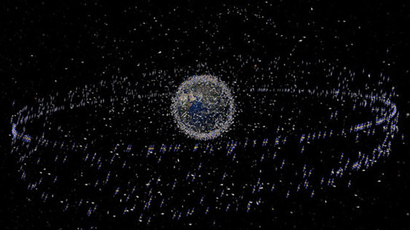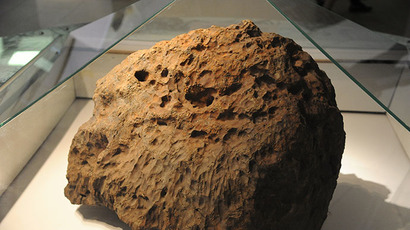Gigantic ‘Beast’ asteroid flying by Earth (VIDEO)

A massive asteroid roughly the size of an entire football stadium that was discovered only months ago is passing by the Earth this week, with professional and amateur astronomers alike having the best chance to watch the flyover on Sunday.
Officially named Asteroid 2014 HQ124, the giant hunk of space mass has been nicknamed the Beast because, at an estimated size of over 1,000 feet wide, it is roughly the size of a Nimitz-class aircraft carrier. Initial estimates guessed that the body’s diameter was between 400 to 900 meters (1,312 to 2,953 feet), although NASA’s NEOWISE has determined the Beast is closer to 325 meters. (The meteor that exploded over Chelyabinsk, Russia measured between 17 to 20 meters in diameter.)
An object of such size could obviously pose a huge threat to Earth, although the Beast will fly no closer to the planet than 3.2 lunar distances (roughly equivalent to 716,500 miles). It would only take an object of about 100 feet wide to be destructive to Earth, according to Wired magazine.
For all of its size, the Beast was only detected on April 23. The NASA Wide-Field Infrared Survey Explorer discovered the Beast flying at approximately 31,000 mph (50,400 kilometers per hour) through space upon examining a fixed backdrop of the star system.
“What’s disconcerting is that a rocky/metallic body this large, and coming so very close, should have only first been discovered this soon before its nearest approach,” Bob Berman, an astronomer with Internet astronomy outreach venture Slooh, told National Geographic. “HQ214 is at least 10 times bigger, and possibly 20 times, than the asteroid that injured a thousand people last year in Chelyabinsk, Siberia.”
“If it were to impact us, the energy released would be measured not in kilotons like the atomic bombs that ended World War II, but in H-bomb type megatons,” he continued. “It will be interesting indeed to watch Slooh track and image this substantial intruder as it passes less than a million miles of us, at a speed 17 times greater than that of a high speed rifle bullet.”
The Beast marks one of the first major asteroids to pass by Earth since NASA and Slooh partnered earlier this year in an agreement that makes it possible for more citizen scientists to become involved with scouring outer space for asteroids flying near Earth. While large objects like the Beast make headlines, countless smaller asteroids and bodies fly over Earth every day unnoticed.
“While astronomers believe we have spotted 90 percent of the potentially dangerous asteroids that are 1,000 feet wide or bigger,” Wired reported, “they estimate that we have detected only 30 percent of the objects that are around 460 feet wide and just 1 percent of the objects the size of the Beast.”
A Slooh video of the flyover is included below:














